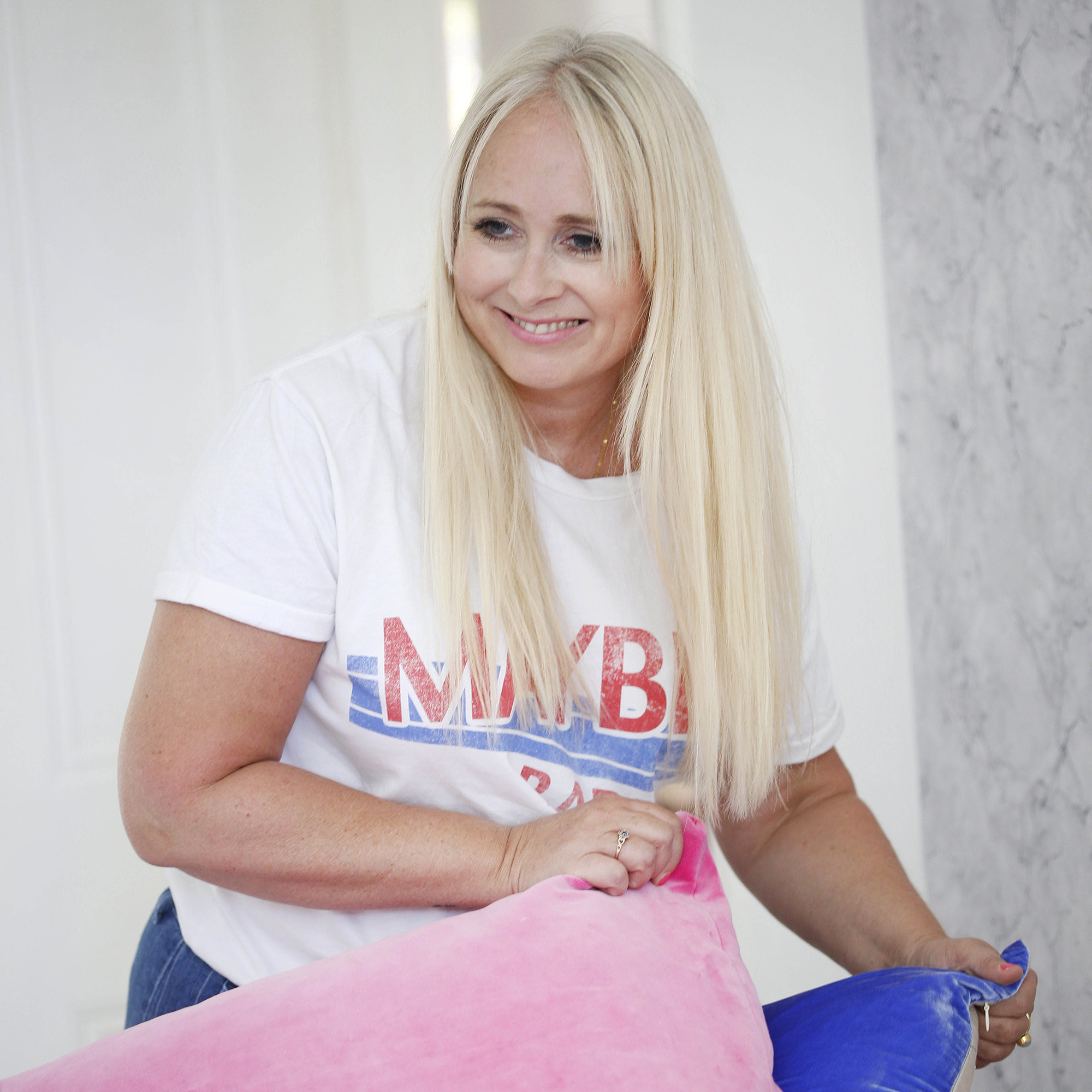How to clean a sofa – expert cleaning tips to make your sofa look good as new
Whether it's fabric, leather or velvet, keep your sofa looking its best by getting the cleaning just right

Lauren Bradbury

A sofa is not just the biggest piece of furniture in your living room. In most cases, it’s also the most expensive. But knowing how to clean a sofa will help you keep your sofa in tip-top condition for years to come, ensuring you get the most out of your purchase.
With constant use, even the best sofas will fall victim to grubby fingers, biscuit crumbs, dirty paws, and general dust and grime. And if you’re trying your best to bring your living room ideas to life, the last thing you want is a dirty sofa sticking out like a sore thumb in the middle of the room. That’s why it’s so important to keep on top of cleaning.
Whether you have a leather sofa, fabric sofa, or velvet sofa, we’ve got the lowdown on everything you need to clean a sofa without spending a fortune on different cleaning products.
How to clean a sofa

Before you get stuck into the nitty-gritty of cleaning a sofa, it’s important to take a step back and make sure that you’re doing the right thing for your sofa. In fact, Margaret Larson from Sustainable Furniture wants everyone to start by doing a patch test, no matter which one of the best upholstery cleaners you're using.
‘Before cleaning your sofa ensure you perform a patch test by using your cleaning products or equipment on a small area of your sofa. Make sure this area is hidden so that if any damage occurs it will not be visible. You will want to keep an eye out for colour loss or abnormal texture. If this appears do not use the product on the rest of your sofa.’
Now you’ve done that, it’s time to get started!
How to clean a leather sofa

Leather sofas are often chosen for their durability and easy wipe-clean material, but how can you ensure your model stays in good condition?
Sign up to our newsletter for style inspiration, real homes, project and garden advice and shopping know-how
1. Determine whether it’s real or faux
Faux leather sofas are becoming increasingly common, but real leather and faux leather have different cleaning requirements. So, you need to determine which one you have before moving onto the next step.
Margaret says, ‘This is important as both fabrics have completely different care guidelines and often it can be difficult to spot the difference between the two.’ For real leather, it’s best to use specialist leather cleaning products. But for faux leather, you can use household cleaners as long as they’re not too harsh.
2. Give it a vacuum
First, remove any dirt by giving your leather upholstery a good vacuum, using the brush attachment if you have one to avoid scratching the material.
3. Wipe away dust
Use a clean cloth to remove any build-up of dust – it's best not to use water or a cleaning agent as some types of leather can be delicate and stain.
4. Use a specialist leather cleaner
Gently wipe your sofa, using a circular motion, with a leather cleaner. 'A specialist conditioner from a quality care kit will help to clean and condition your sofa, reviving the sheen of the leather and preserving its soft suppleness,' says Suzy McMahon, buying director at Sofology. 'To prevent the leather losing its colour or from becoming dry, apply this conditioner twice a year.'
How to clean a fabric sofa

Fabric sofas can be easier to clean than you think, no matter how light in colour the covers – including neutral and grey sofa living room ideas.
1. Clean any surface dirt
Start by removing throws and cushions, checking down the sides and back for any loose change or sweet wrappers, etc, then give your sofa a vacuum using the upholstery attachment. Make sure to vacuum the seams and any crevices, and repeat on all your cushions.
2. Check the label
Before you start cleaning the covers, make sure you check the label to see what products you can use on your sofa.
- W means you can only use a water-based cleaner. S or P means it can only be cleaned with solvents (dry-clean only).
- SW or WS means that you can use either a water-based detergent or solvent cleaner. A steam cleaner will be fine to use, too.
- Finally, X means that you can’t use any water or detergent on the surface – get it professionally cleaned instead.
If your sofa allows, wipe down the cushions with a clean, damp cloth to remove any dust and dirt, and stop any staining. If you're trying to work out how to clean a linen sofa, then be extra careful as they are prone to water stains.
3. Remove any stains or smells
There are some easy home remedies that will help remove stains and spills. Firstly, white vinegar is a great natural stain remover for most types of upholstery. Use it to blot the stain with an equal parts water and vinegar solution, then wipe the stain away gently using a microfibre cloth (only use a new cloth or make sure it’s completely clean). Follow this up with a mixture of mild detergent and tepid water to remove any lingering vinegar smell and leave it to dry naturally.
Baking soda is good for removing any unwanted sofa smells – apply a sprinkling of it to the area, leave it for 15-20 minutes and then vacuum clean it.
4. Give it a steam clean
Cleaning expert and Instagram sensation Lynsey Queen of Clean swears by a steam cleaner for keeping her sofa in tip-top condition. ‘I steam clean mine with a handheld steamer,’ Lynsey explains. ‘What steam will do is it will refresh it. It will kill any germs and bacteria that’s in the sofa. And if there are any stains on there, it will help the stain lift,’ she adds.
Sadly, the steam cleaner may not remove the stain completely and you will need to go back over it with a stain removal product, but it will refresh your sofa no end.
5. Repeat every 2 weeks
Fabric sofas can trap dirt and grime very easily and quickly, so it’s a good idea to keep on top of a sofa cleaning schedule.
Margaret suggests, ‘Dry clean roughly every 2 weeks to keep on top of the appearance of your sofa, and if using a brush, ensure it is soft to avoid scratching the fabric.’
How to clean a velvet sofa

It used to be the case that velvet was a no-go for anyone with pets and/or small children, but these days, easy-care fabric (most are no longer silk based) makes it easy for us to enjoy having a luxurious finish without the hassle of ridding it of marks.
1. Remove dirt and dust
Gentle vacuuming is key for cleaning a velvet sofa, so use slow circular motions to rid it of any debris. Another alternative is to use a lint roller instead, which does the job quickly and easily – however you'll still need a vacuum for those under-cushion and hard-to-get-to areas.
2. Give it a brush
You can buy soft metallic brushes that are designed specifically for velvet, and these are great for maintaining your sofa's sheen. Be sure to brush in the direction of the pile.
3. Treat it to steam
If your sofa allows (you'll need to check the label to see if you can use water on your sofa), use a handheld steamer to prevent marks and creases. Use it on a low setting and move the steamer constantly to keep it from staying on any one spot for too long and damaging the fabric.

FAQs
How do I clean sofa stains?
'Speed is key when it comes to spills and stains,' says Sofology's Suzy McMahon. 'Try to remove the stain as soon as you notice it by blotting with water and paper towels and avoid rubbing the fabric, as this will likely spread the colour. Use a solution of soapy water and a clean white towel to blot until you’ve removed the colour. '
'To avoid water marks after cleaning we advise that you dampen a colourfast cloth with boiled water from a kettle and gently wipe the entire panel or cushion from seam to seam. This will help to prevent any water stains as the fabric dries.'
How often should you clean a sofa?
Until you spill something or a stain mysteriously appears, it can be easy to ignore upholstery cleaning, however given how often your sofa is used and how much hidden dirt and dust can build up, it’s good to give it a freshen up each week if you can, to keep it looking its best. A quick vacuum will rid it of any dust or dirt that could, over time, dull your sofa's colour and affect the material.
'There’s no denying sofas require regular maintenance, and no matter how hard you try to keep your brand-new sofa looking as spotless as the day it came home, it’s inevitable some pesky stains will show up over time,' says Sofa.com's Patricia Gibbons. 'You often won't have to do the whole top-to-toe deep clean, but we recommend lots of spot cleaning and opting for fabric protection to help your sofa keep its new, fresh look.'
Victoria Cedeno, Brand Specialist at Zinus adds, 'You’ll want to vacuum your sofa on a fairly regular basis to keep it cleaner longer, making sure to vacuum once a week or twice a week if you have pets or kids.'
How do you clean a sofa that can't be washed?
Cleaning a sofa is made much easier when you have removable cushion covers you can pop in the washing machine. But how you clean a sofa that can’t be washed depends on the type of sofa you have.
If you have a leather sofa, you should give it a vacuum, wipe away any dust, and then use a specific leather cleaner to clean it. If you have a fabric sofa, you should first clean any surface dirt before giving it a steam clean. If you have a velvet sofa, you should brush off the dirt and dust and then steam clean it.
This way, you can protect the material of the sofa while still giving it a deep clean at the same time.
Follow these steps and you'll have a clean sofa in no time.

Laurie Davidson is a professional stylist, writer and content creator, who lives and breathes interiors. Having worked for some of the UK’s leading interior magazines, styled homes up and down the country and produced sets for TV shows, adverts and top brands, it’s safe to say Laurie has had a pretty exciting career. Find her on Instagram at @lifeofaninteriorstylist or over at lauriedavidson.co.uk
- Lauren BradburyContent Editor (House Manual)